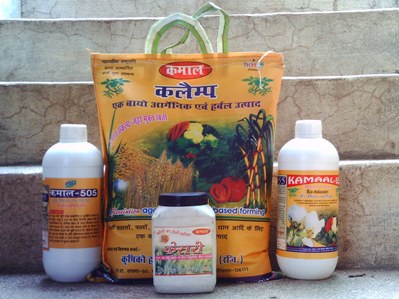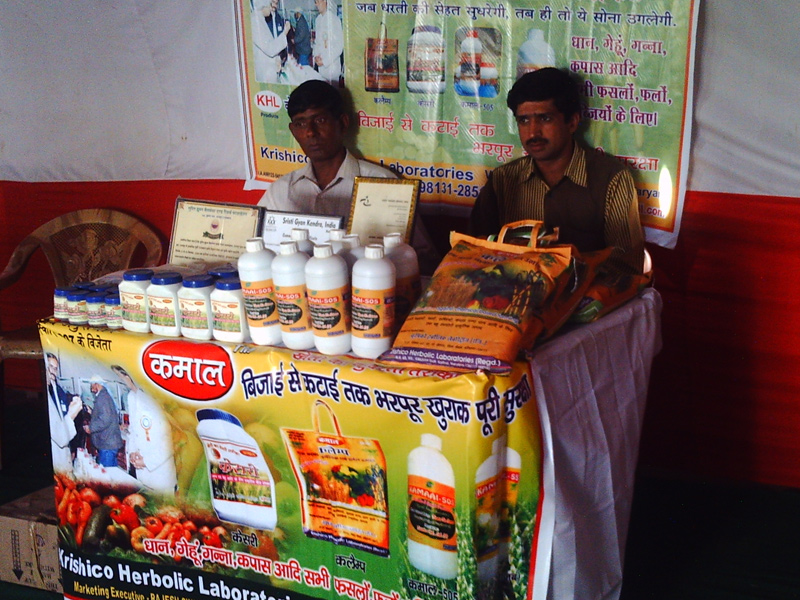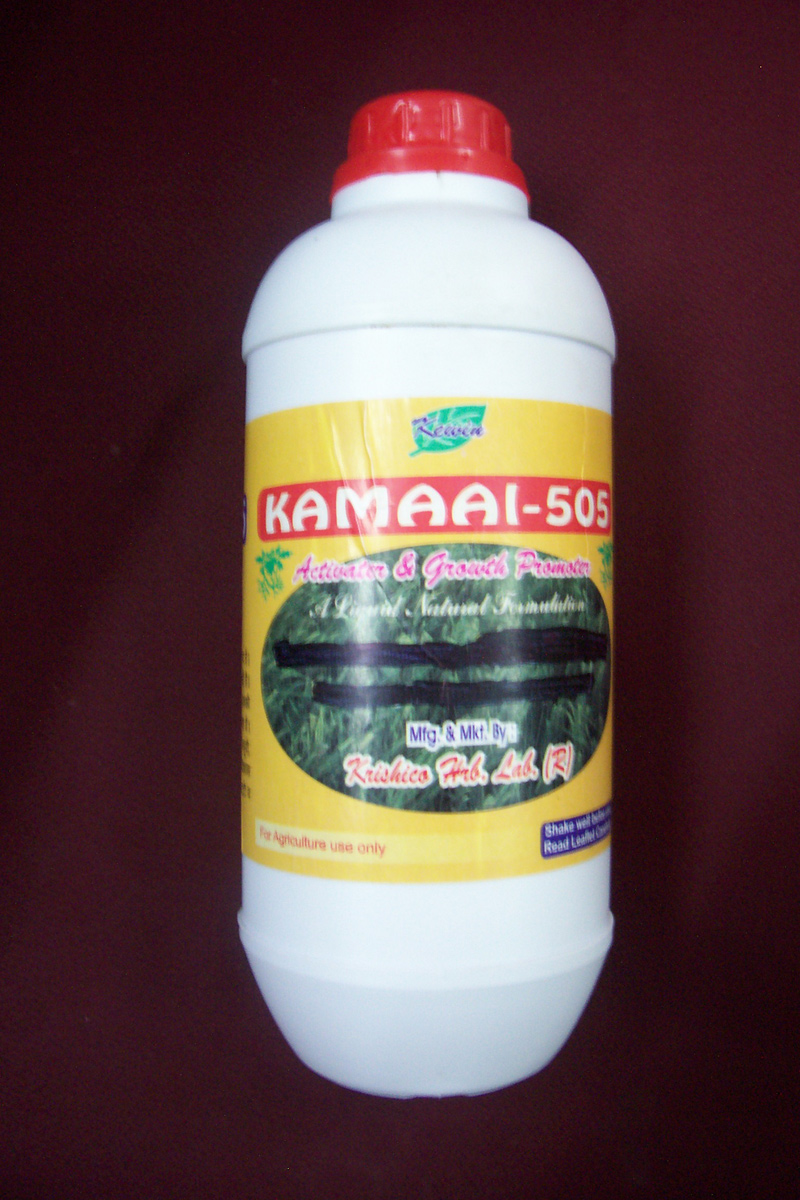Excessive reliance on chemical fertilizers and their imbalanced use has affected soil health. The micronutrient deficiency in soil has increased. Organic carbon which is very essential to hold the important nutrients in the soil, has also decreased drastically. Loss of Organic carbon can lead to reduction in soil fertility, land degradation and even desertification.
This is a “multiutility innovation” based on plant ingredients. It acts as growth promoter, fungicide, and termiticide. Due to its high organic content, it improves soil fertility, increases water intake and enhances water-holding capacity of the soil. Thus, it can also be used for soil reclamation.
Shri Ishwar Singh Kundu (45) has developed a multi utility herbal formulation, which can be used as a bio-fertiliser, soil enhancer and as an insect pest control formulation for a variety of crops.His family consists of his mother, his wife and three young children all of whom are studying. Shri Kundu's father was in military but later left the services to practice agriculture. He had around 70 acres of land but since their family was typically joint family, after partition his share came to be only 2 acres on which he today grows wheat and rice.He had his education in the village itself then after 10th moved to Kaithal to do his ITI course (1984-86). After the completion of the course he started looking for various jobs but could not find any. So he returned back in 1986 to his village to do agriculture. Along with his farming he kept on trying to get a job but as fate would have it he could not land up anywhere. So finally in 1988 he decided to set up a seed and pesticide shop at Kaithal in partnership with another person. The work was fine but some how things did not work out well between the two so he returned back to his home in 1992 establishing his workshop of agricultural repair where he mended small agricultural implements, pumps, etc.During the ITI times he had some interest in journalism too and used to send articles to various newspapers etc. He even started a newsletter, `Janta Leader' in 1985 and continued its publication till 1992 with the help of his friends. Then during 1993-95 he shifted to Faridabad again to work with an acquaintance of his. But had to return back again to his place after having another bitter experience. Then again he started his workshop of agricultural machinery, vacuum pumps, etc.
Genesis
It was somewhere in the year 2000 when he went to his brothers place in Raigarh, who was working in Jindal Steels and landed up in a job there. An unfortunate accident forced him to leave his job and return back to Kaithal in October 2001.After recuperating at home for a few months he restarted his workshop and hired a person to help him. Then he also started his experiments in herbal insecticides and pesticides as he had prior experience of this. For his experiments he used to perform trials on his own farm. In 2004, he and his friend from a nearby village started visiting to neighboring villages, covering distances of up to 70-80 km, to demonstrate their pesticide at farmer's fields. At many times they had to leave the samples with the farmers to test and return back after months to find that they have been left untouched. The very mention of the word `herbal' used to irritate the farmers. They had a hard time trying to explain the merits of herbal formulations on the plant and the ill effects of inorganic pesticides and fertilizers. Somehow he managed to get certain response from some farmers and as a result he was able to sell around few thousand rupees of his herbal formulation. The farmers who used his formulation were quite satisfied with the results. The results the formulation gave in some areas of the rice belt of Kurukshetra region were noteworthy.When initially he started developing his formulation he used to test it by spraying it on the vegetables in his farm. Then later he started experimenting, changed the formulation and tried it on paddy by mixing it with the fertilizer and spreading on the ground. This technique gave him excellent results. Slowly he started to reduce the quantity of the fertilizer mixed along with the pesticide. It was noticed that the pesticide worked effectively as an insecticide as well as a growth promoter. When given to the farmers for testing, the product received good feedback. Apart from giving good results in rice crop it also shows promising effect in maize and jowar. Presently he is testing it on Aloe Vera crops in Punjab.According to him, use of pesticide in his area is in large scale and because of that pollution of air, soil and water has increased. Even fodder for animal and drinking water is being polluted. Hence he thought of preparation of herbal pesticide.The main problem he faced was in getting acceptance for his product. People did not use to try it and keep his sample for months. It pained him to see the sample of his product lying as waste in one corner of the field. Sometimes people used to show him that corner of the field which did not have proper yield and say that this was as a result of his product and his herbal medicine did not work. This may be because then they would have had to pay for the sample which they initially got for testing from him. The people in his own village also never believed him and would say that he boiled some leaves in water and was fooling people by selling it. But now since farmers from other villages have started showing some sort of an interest in his product so now people in his village are slowly showing interest in his work.
Innovation
He started experimenting with Neem (Azadirachta indica). First he boiled neem leaves in water and sprayed this solution on crop. Result was optimistic and he proceeded further. In the second phase he mixed neem oil with the solution and got better result. He developed his technique and used Neem leaves, Neem oil, Chirayta, Kaner, Jaggery along with a couple of other herbs. All these herbs are mixed with urine of cow in a vessel and put in soil with the vessel. After fifteen days it gets decomposed. The solution is then filtered. If more effectiveness is required neem leaves decoction can be added to it.He used a liter of herbal solution (stock solution) with 100-liter water and sprayed on paddy crop with good results. All kind of insects and pest were killed and others ran away from the field. The animals also do not eat this crop because the presence of the solution on the leaves makes its taste bitter. The solution has been found to be effective in vegetables also. Feedback from the users indicates that it is helpful in controlling termite also. It acts as a pesticide, insecticide and growth promoter also because after using it the quantity of fertilizer required becomes very less. Though he is trying as hard as he possibly can do with his limited resources Kundu feels if some marketing support is provided then he possibly can do better. Since he hardly receives any cash in advance, it becomes difficult for him to maintain the supply as he is already cash stripped. So he is also looking forward to some sort of a loan, which can help him fulfill the demand for his product, which he believes is going to be great in the coming season. He also wants to open a NGO, the main objective of which would be to educate the people about the merits and demerits of organic and inorganic farming.
Innovator has been awarded in third Award Function by National Innovation Foundation and supported under MVIF scheme.
Indian Patent Applied (No.: 1104/DEL/2007)
| Crops/Purpose |
Dose |
Process of Application |
| Soil treatment (with low organic Carbon) |
8-10 kg |
Before sowing or transplanting. Note: If soil is sandy than broadcast just before watering/irrigating |
| Rice, wheat and other field crops |
5-8 kg per acre |
- 20 days after transplanting/sowing and irrigating the field 1-2”
- At the time of flowering/budding
|
| Sugar cane |
10-16gm per acre |
- Do - |
| Horticultural trees |
- Less than 1 year
- 3-4 years
- Older trees
- Old orchards
|
- 250-500 gm
- 2 -3 kg
- 4 – 5 kg
- 25-30 kg mixed with sand and other fertilizers. Gives best result if ploughed in soil and irrigated after application
|
| Gardens crops |
- |
30-50gm per sq. ft |
- It is a good source of zinc (27.35 mg/kg), copper (5.11 mg/kg) and manganese (173.60 mg/kg)
- It is good source of Organic Carbon (45.7%)
- It is free from harmful elements like Arsenic
- Improves soil micro and macro fauna
- Cost of cultivation decreases upto the extent of about 47%
- It enhances water holding capacity of saline and compact soil
- It enhances water holding capacity of saline and compact soil










